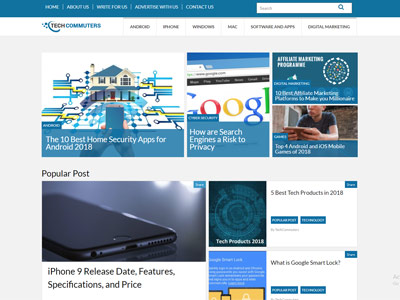The Development of the Best tech blog: A Journey With Tech Background and Future Trends
The Development of the Best tech blog: A Journey With Tech Background and Future Trends
Blog Article
Understanding the Surge of Edge Computing in Today's Digital World
In the rapidly progressing landscape of modern technology, side computer arises as an essential force, improving exactly how data is refined and utilized. By transitioning information administration closer to the source, edge computing addresses critical latency concerns while enhancing bandwidth use and enhancing protection steps.
What Is Side Computing
Edge computer, although a reasonably recent innovation in the realm of modern technology, essentially changes how data is refined and handled by bringing computation and data storage closer to the place where it is needed. Unlike standard cloud computing designs, which typically rely upon central data facilities that can be geographically remote, side computing decentralizes data handling. This distance decreases latency, boosts real-time information handling, and enhances the total individual experience by ensuring much faster response times.
At its core, side computing includes a network of local devices and infrastructure, such as sensors, gateways, and routers, with the ability of refining data at or near the source. This localized processing ability is specifically important for applications requiring immediate data evaluation, such as autonomous lorries, industrial automation, and clever cities. Furthermore, by offloading information processing jobs from central servers, edge computer decreases bandwidth demands and enhances information privacy and security, as sensitive information can remain on-site as opposed to going across considerable networks.

Key Chauffeurs of Adoption
Several elements are propelling the fostering of edge computing in today's digital landscape. Among the main chauffeurs is the exponential rise in connected devices, commonly described as the Web of Things (IoT) This surge creates substantial quantities of information that require to be processed quickly and efficiently. Side calculating addresses this demand by allowing data processing closer to the data source, minimizing latency and improving real-time decision-making abilities.
An additional substantial driver is the demand for enhanced transmission capacity performance. Centralized cloud systems can end up being overloaded with the large volume of data produced by IoT gadgets, causing bottlenecks (Best tech blog). By processing information at the side, companies can minimize network congestion and improve overall system performance
Additionally, safety and security and privacy worries are pressing organizations toward side computer. By processing sensitive information in your area, business can reduce dangers connected with information transmission and direct exposure to prospective cyber risks.
The rise of applications requiring real-time processing, such as independent automobiles and boosted reality, additionally requires the rapid action times that border calculating offers. Collectively, these vehicle drivers are making edge calculating an essential component of contemporary IT infrastructure, leading the way for its prevalent fostering throughout different sectors.
Benefits Over Cloud Computing
Exactly how does side computer identify itself from standard cloud computing? Mainly, edge computing brings information handling closer to the source of data generation, often on local devices or neighboring servers, rather than depending on central data.
Furthermore, side computer improves transmission capacity effectiveness (Best tech blog). By processing data locally, only the essential information is transferred to the cloud for additional evaluation or storage space, lowering the quantity of data that goes across the network. This not just eases network blockage however also decreases information transmission expenses
Edge computing likewise offers enhanced data privacy and safety and security. Delicate information can be refined locally without being sent to the cloud, lessening the exposure to potential cyber dangers. This is especially valuable for markets dealing with private information, such as medical care and monetary solutions.
Furthermore, side computing makes sure greater durability and integrity. Regional handling allows for proceeded operation even when connectivity to the cloud is compromised, keeping important features and solutions regardless of possible network disruptions. These advantages jointly show side computing's transformative possibility in enhancing efficiency and protection in digital communities.
Challenges and Factors To Consider
While side computer provides various advantages, it additionally provides unique obstacles and factors to consider that need to be resolved to try this site totally recognize its potential. Furthermore, managing and keeping an eye on a decentralized network of edge tools can be intricate, calling for innovative tools and techniques to guarantee smooth operation and upkeep. Best tech blog.
An additional factor to consider is the scalability of side computer remedies. As the variety of linked tools expands, so does the demand for processing power at the side, which can cause resource constraints. Organizations has to carefully plan their facilities to suit this growth without compromising efficiency or performance.
Interoperability is an additional critical aspect. With different software and hardware parts entailed, ensuring compatibility and smooth integration can be difficult. Standardization initiatives are necessary to facilitate communication between disparate systems.
Future Trends in Edge Computing
Expecting the future, side computing is positioned to change numerous sectors by enabling quicker data handling and minimizing latency. As the quantity of data created by IoT gadgets proceeds to grow, edge computing will end up being increasingly vital in managing this increase effectively.
One more arising trend is the development of edge-native applications developed specifically to leverage the distinct abilities of side computing. These applications will maximize efficiency and resource application, leading to boosted performance across different sectors. Innovations in 5G innovation will better reinforce side computing by providing the go to my site essential facilities for high-speed, low-latency communication between gadgets and edge nodes.
Conclusion
Side computer's rise is driven by the expansion of IoT devices and the need for real-time data processing, which improves effectiveness by decreasing latency and decentralizing information monitoring. This approach mitigates bandwidth ineffectiveness and security issues, facilitating developments in applications like clever cities and self-governing lorries. In spite of challenges such as facilities complexity and integration, the future of edge computing promises an extra receptive digital environment, with continued advancements forming its advancement and expanding its applicability throughout markets.
Edge computing, although a relatively current innovation in the Clicking Here world of modern technology, basically changes just how information is processed and taken care of by bringing calculation and information storage space closer to the place where it is needed. Unlike typical cloud computing models, which usually count on central data facilities that can be geographically remote, side computing decentralizes information handling. Additionally, by unloading information processing tasks from central web servers, edge computer lowers data transfer requirements and boosts information privacy and protection, as delicate details can continue to be on-site rather than going across comprehensive networks.

Report this page